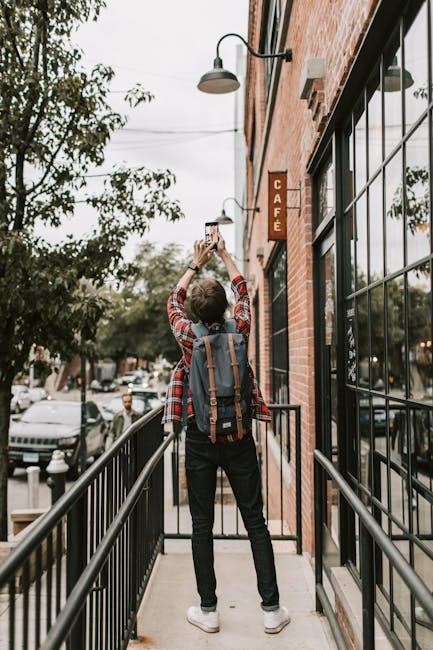mens belt size guide
Men’s belt sizing is crucial for both style and functionality․ Typically, belt size is 2 inches larger than pant size, ensuring a comfortable and secure fit․ Proper sizing varies by material, with leather, canvas, and metal belts offering unique measurements․ Accurate sizing ensures optimal comfort and style, making it essential to measure correctly or refer to size charts for the perfect fit․
How to Measure Your Belt Size
To measure your belt size, use a tape measure around your natural waistline where the belt is worn․ Add 2 inches to your pant size for an accurate fit․
2․1 Using a Tape Measure for Accurate Measurement
For precise sizing, wrap a tape measure around your natural waistline, typically at the narrowest point above your hips․ Breathe naturally and keep the tape snug but not tight․ Record the circumference in inches or centimeters․ This measurement directly corresponds to your belt size, ensuring a comfortable and secure fit without relying on pant size alone․ This method is the most reliable for accurate belt sizing․
2․2 Using an Existing Belt as a Reference
To determine your belt size using an existing belt, measure from the buckle tip to the hole you use most․ This gives your current belt length․ Note that leather belts may stretch, so measure an unused or minimally stretched belt․ Compare this measurement to a size chart, considering that belt size is typically 2 inches larger than pant size․ This method ensures accuracy when selecting a new belt, especially for online purchases without the option to try it on․
2․3 Converting Pant Size to Belt Size
Converting pant size to belt size typically involves adding two inches to your pant size․ For example, if your pants are a size 34, your belt size would be 36 inches․ This rule is widely used across different brands and sizing charts․ However, it’s important to consider factors like waist circumference, belt material, and brand-specific size charts for accuracy․ Measuring your waist or using an existing belt can provide a more precise fit, especially when accounting for variations in stretch and style preferences․

Understanding Belt Size vs․ Pant Size
Belt size is typically 2 inches larger than pant size for a secure fit․ However, this can vary based on material and brand-specific sizing standards․
3․1 The General Rule: Pant Size + 2 Inches
The standard rule for men’s belt sizing is to add 2 inches to your pant waist size․ This ensures the belt fits comfortably and securely․ For example, if your pant size is 34 inches, your belt size should be 36 inches․ This guideline applies universally, although specific materials like leather may require slight adjustments․ Always refer to the brand’s size chart for precise measurements․
3․2 Why Belt Size Differs from Pant Size
Belt sizes differ from pant sizes to accommodate clothing thickness and comfort․ Belts need to fit over pants, adding bulk, so they are typically 2 inches larger than pant sizes․ This ensures a comfortable fit without feeling restrictive․ Additionally, belt materials like leather may stretch over time, requiring a slightly longer initial size․ The extra inches also allow for different wearing positions, such as lower on the hips, enhancing both style and functionality․
Types of Belts and Their Sizing
Leather, canvas, and metal belts vary in sizing due to material thickness and flexibility․ Leather belts often follow standard sizes, while canvas belts are measured in centimeters, and metal belts offer fixed lengths, ensuring a tailored fit for different styles and preferences․
4․1 Leather Belts
Leather belts are a classic choice, offering durability and style․ To ensure the perfect fit, your belt size should be 2 inches larger than your pant size․ For example, if your pants are size 34, opt for a 36-inch belt․ Measure around your natural waistline or use an existing belt as a reference․ Leather belts may stretch slightly over time, so a snug fit is ideal․ Refer to size charts for accurate measurements, as sizes can vary by brand and style․
4․2 Canvas Belts
Canvas belts are lightweight and versatile, ideal for casual outfits․ When choosing a canvas belt, your size is typically the same as your pant size, without the additional 2-inch rule applied to leather belts․ Canvas belts are flexible and adjustable, offering a comfortable fit․ They are perfect for summer or relaxed settings․ Measure around your waistline or refer to a size chart to ensure the best fit, as canvas belts do not stretch like leather and are designed for a precise measurement․
4․3 Metal Belts
Metal belts are sleek and modern, offering a minimalist look․ They are often adjustable, allowing for a precise fit without fixed holes․ When sizing a metal belt, measure the circumference of your waist where the belt will sit․ Metal belts are lightweight and durable, making them a great option for casual or formal outfits․ Their adjustability ensures comfort and style, with sizes typically ranging in small increments for a tailored fit․
Men’s Belt Size Chart
A men’s belt size chart provides standard measurements, typically ranging from 28 to 50 inches․ Sizes are often converted internationally for consistency, ensuring a universal fit guide․
5․1 Standard Belt Size Chart
A standard belt size chart typically ranges from 28 to 50 inches, with sizes incrementing by 2 inches․ For example, a 34-inch belt fits a 32-inch waist․ This chart serves as a universal guide, helping men choose the right size based on their waist measurement․ It ensures a comfortable and secure fit, accommodating different body types and styles․ Reference this chart for accurate sizing when selecting a belt․
5․2 International Size Conversions
International belt size conversions help men shop globally with confidence․ For example, a UK size 28 belt corresponds to a US size 22 and an EU size 85․ Similarly, a UK size 34 belt matches a US size 26 and an EU size 90․ These conversions ensure a consistent fit across brands from different regions․ Referencing size charts with international standards makes it easier to select the correct belt size while shopping abroad or online․

How to Adjust Your Belt Size
To adjust your belt size, measure your natural waistline with a tape measure․ Add 2 inches for a standard fit or adjust based on how your pants sit․ Ensure the belt fits comfortably, neither too tight nor too loose, for optimal style and functionality․
6․1 Adjusting for the Perfect Fit
Adjusting your belt for the perfect fit ensures comfort and style․ Measure your waist where the belt will sit, typically 2 inches above the hips․ Add 2 inches to your pant size for your belt size․ Use a tape measure to find the circumference, ensuring the belt isn’t too tight or loose․ For leather belts, consider the natural stretch over time․ Proper adjustment ensures the buckle sits centered, creating a balanced look․ Always refer to the size chart for accurate sizing, especially when ordering online․ This method works for most materials, including canvas and metal belts, ensuring a precise fit every time․ By following these steps, you can achieve a comfortable and stylish belt fit effortlessly․
6․2 Tips for Ensuring Comfort and Style
For optimal comfort and style, choose a belt that fits naturally without restricting movement․ Ensure the belt isn’t too tight or loose, sitting comfortably at your natural waistline․ Select materials like leather or canvas for durability and a polished look․ Match the buckle style to your outfit, opting for simplicity in casual settings and elegance for formal wear․ Always coordinate the belt color with your shoes and accessories for a cohesive appearance, enhancing both comfort and aesthetic appeal․

Choosing the Right Belt for Your Outfit
Coordinate your belt with your shoes and outfit for a polished look․ Match the color and style to complement your attire, ensuring a seamless and stylish appearance․
7․1 Matching Belt Color to Shoes and Belt
Ensuring your belt color complements your shoes is key to a cohesive look․ For formal outfits, opt for a belt that matches your shoes exactly, creating a polished appearance․ In casual settings, coordinating colors or neutral tones like brown or black can enhance your style․ This simple yet effective tip elevates your outfit, ensuring a sophisticated and put-together look effortlessly․ Proper coordination ensures a balanced and fashionable ensemble always․
7․2 Selecting the Right Buckle Style
Selecting the right buckle style enhances your outfit’s aesthetic․ For formal events, opt for sleek or minimalist buckles in silver or gold tones․ Casual settings allow for more unique or bold designs․ Consider the buckle’s material and finish to match your other accessories; Ensure the buckle’s size complements the belt’s width for a balanced look․ Personal style and functionality should guide your choice, making it a seamless addition to your overall ensemble․ Proper buckle selection elevates your fashion effortlessly․

Common Mistakes When Selecting a Belt Size
Common mistakes include incorrectly measuring waist size and ignoring the difference between belt and pant sizes, leading to an ill-fitting belt that compromises comfort and style․
8․1 Incorrectly Measuring Waist Size
Incorrectly measuring waist size is a common error․ Many men measure too tightly or loosely, leading to improper belt fit․ Use a tape measure around the natural waistline, keeping it level and snug but not overly tight․ Ensure the tape isn’t twisted for accurate results․ This mistake often causes discomfort and an unflattering appearance, emphasizing the importance of precise measurement for the perfect belt size․
8․2 Ignoring the Difference Between Belt and Pant Sizes
Ignoring the difference between belt and pant sizes is a frequent mistake․ While pant size relates to waist circumference, belt size accounts for additional length needed for a secure fit․ Assuming they are the same often leads to an ill-fitting belt․ Always add 2 inches to your pant size for the correct belt size, as belts need extra length to function properly and ensure comfort and style․
Belt Care and Maintenance Tips
Proper belt care ensures longevity and style․ Clean leather belts with conditioners, avoid harsh chemicals, and store them flat to prevent cracking․ Regular maintenance preserves quality and appearance․
9․1 Cleaning and Conditioning Leather Belts
Cleaning and conditioning are essential for maintaining leather belts․ Use a soft cloth to gently wipe away dirt and stains․ Apply a leather conditioner or oil to keep the material supple and prevent cracking․ Avoid harsh chemicals, as they can damage the finish․ Regular conditioning ensures the belt remains durable and retains its luxurious appearance over time․ Proper care extends the life of your leather belt, keeping it stylish and functional for years to come․
9․2 Storing Belts Properly
Store belts in a cool, dry place to prevent damage․ Avoid folding or creasing, as this can weaken the material․ Roll leather belts to maintain their shape and prevent cracks․ Use a protective cloth or box to shield from dust and moisture․ Keep belts away from direct sunlight and extreme temperatures to preserve their quality and extend their lifespan․ Proper storage ensures your belts remain in excellent condition for years․
Frequently Asked Questions About Belt Sizing
Discover answers to common questions about belt sizing, such as how to determine your size and whether pant size accurately reflects belt measurements for a perfect fit․
10․1 How Do I Know My Belt Size?
To determine your belt size, measure the natural waistline where the belt will sit․ Alternatively, add 2 inches to your pant size․ Use a tape measure for accuracy or refer to standard size charts․ Ensure the belt fits comfortably without being too tight or loose, providing the perfect balance of style and functionality for your outfit․
10․2 Can I Use My Pant Size to Determine My Belt Size?
Yes, you can use your pant size as a reference for determining your belt size․ Typically, add 2 inches to your pant size to find your belt size․ For example, if your pants are size 34, your belt size would be 36․ This guideline ensures a comfortable fit and proper functionality․ However, always check specific size charts for accuracy, as variations may exist between brands and styles․
